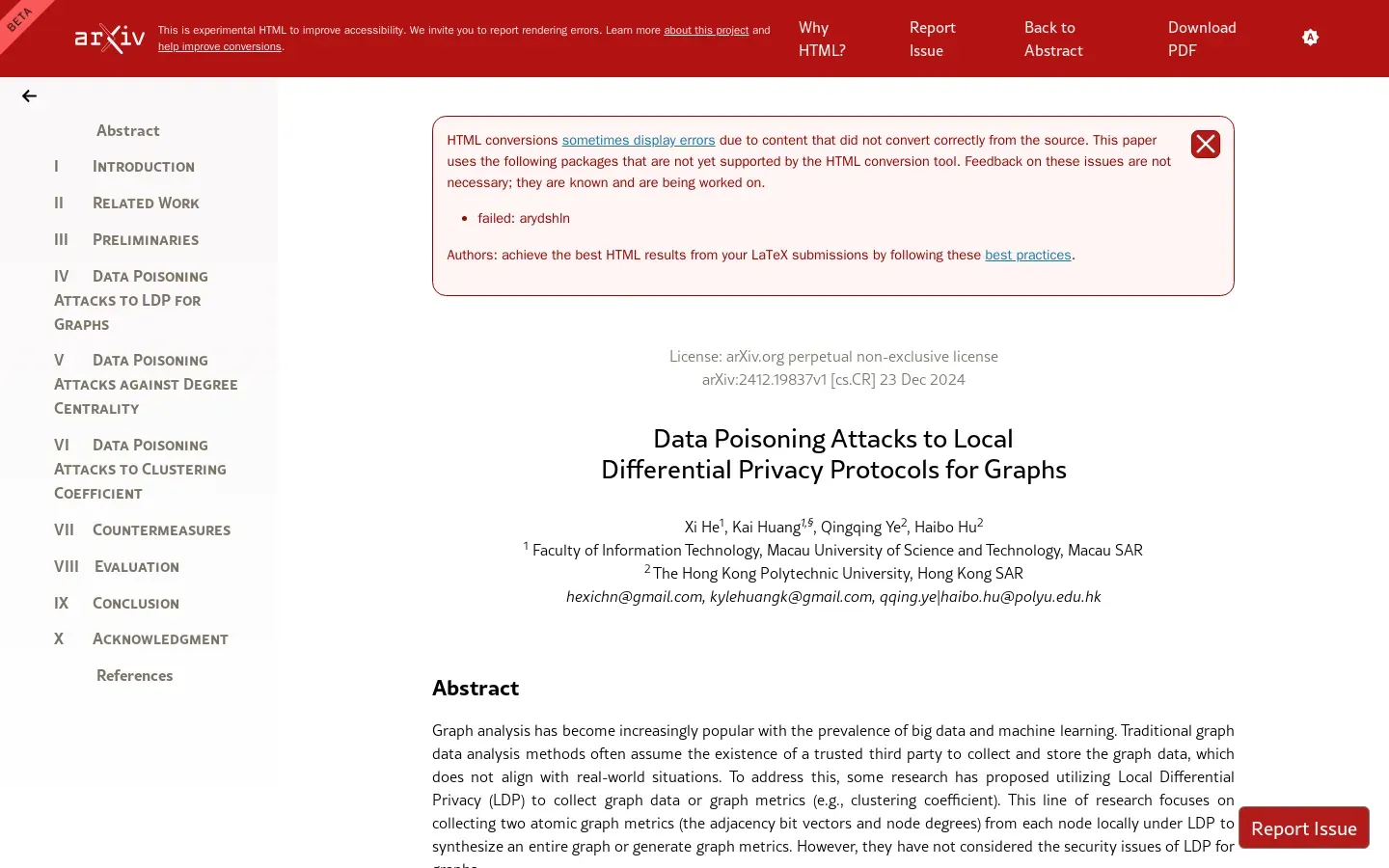
Data Poisoning Attacks Impact Local Differential Privacy Protocols
/ 4 min read
Quick take - Recent research has focused on developing effective countermeasures against data poisoning attacks and enhancing network resilience, particularly in privacy-preserving protocols and smart city infrastructures, by exploring various cyber attack strategies and evaluating detection techniques.
Fast Facts
- Recent research focuses on countering data poisoning attacks, particularly in privacy-preserving protocols and smart city infrastructures, to enhance network resilience.
- The study investigates various cyber attack strategies, including Maximal Gain Attack (MGA) and Random Node Attack (RNA), using experimental evaluations and detection techniques.
- Key findings reveal vulnerabilities in privacy-preserving protocols, emphasizing the need for effective defenses and the use of tools like Detect1, Naive1, and the LF-GDPR framework.
- The research highlights the strengths and limitations of existing detection methods, advocating for further investigation into robust defenses to improve cybersecurity.
- Future directions include developing countermeasures with fewer false positives, optimizing detection thresholds, and ensuring ongoing policy development to address evolving cyber threats.
In an era where our digital footprints are omnipresent and the stakes of cybersecurity have never been higher, researchers are hard at work developing innovative solutions to tackle increasingly sophisticated cyber threats. As data becomes a prized asset for both organizations and malicious actors, the focus on countermeasures that can effectively safeguard this information is paramount. Future research could concentrate on crafting more robust countermeasures that not only minimize false positives but also broaden the scope of detectable attack strategies. The need for enhanced defenses is underscored by the rise of data poisoning attacks, a tactic that seeks to undermine the integrity of machine learning models by injecting deceptive data during the training phase.
The implications of these data poisoning attacks extend far beyond theoretical discussions; they pose real risks to privacy and data integrity, particularly in applications such as healthcare and social network analysis. A pivotal area for exploration lies in understanding the dynamics of these attacks. The Maximal Gain Attack (MGA), for instance, represents a particularly insidious strategy wherein attackers maximize their impact by strategically targeting nodes within a network to compromise its functionality. Research into methodologies like the Random Node Attack (RNA) highlights the importance of recognizing how vulnerabilities can be exploited and emphasizes the need for adaptive detection mechanisms capable of evolving alongside emerging threats.
Key findings from recent studies reveal that tools designed for fake node detection are integral to mitigating risks associated with privacy-preserving protocols in graph data collection environments. While techniques such as Local Differential Privacy (LDP) offer promising avenues for securing sensitive information, they are not without limitations. Current frameworks must address issues related to threshold variation and impact analysis to ensure effective detection mechanisms are in place. The development of robust frameworks like the LF-GDPR Framework serves as an essential step toward enhancing security protocols for decentralized networks, where traditional defenses may falter.
As researchers investigate these complexities, it becomes evident that robust countermeasures against data poisoning are crucial. A comprehensive understanding of existing strengths and limitations allows for targeted improvements that can significantly bolster defenses. Future research directions should also include a comparative analysis of different detection methods, fostering an environment where best practices can emerge. This approach would not only enhance resilience against sophisticated attacks but also ensure the integrity and reliability of critical systems we rely on daily.
Moreover, advancing our knowledge in areas such as threshold optimization for detection mechanisms will play a vital role in fortifying defenses against evolving cyber threats. With each discovery, there is an opportunity to refine our understanding of attack vectors and develop tools that provide deeper insights into safeguarding our digital landscapes.
The road ahead necessitates a collaborative effort between researchers and practitioners to cultivate an environment where cybersecurity measures can keep pace with the rapid advancements in attack strategies. By prioritizing policy and regulation development alongside technical innovations, we can create a more secure future for all stakeholders involved. As we continue to unravel the intricacies of cyber threats, the overarching goal remains clear: to enhance the resilience of networks against sophisticated attacks and safeguard the critical infrastructures that underpin our modern society.



